Enterprise Asset Management (EAM) Market Size 2025-2029
The enterprise asset management (eam) market size is valued to increase by USD 2.46 billion, at a CAGR of 8.1% from 2024 to 2029. Growing number of partnerships and acquisitions will drive the enterprise asset management (eam) market.
Market Insights
- North America dominated the market and accounted for a 35% growth during the 2025-2029.
- By Deployment - On-premises segment was valued at USD 2.28 billion in 2023
- By Sector - Large enterprises segment accounted for the largest market revenue share in 2023
Market Size & Forecast
- Market Opportunities: USD 110.41 million
- Market Future Opportunities 2024: USD 2458.60 million
- CAGR from 2024 to 2029 : 8.1%
Market Summary
- The market encompasses solutions and services that enable organizations to effectively manage and maintain their physical assets to maximize their productivity and efficiency. The global market is driven by various factors, including the increasing complexity of asset portfolios, the need for regulatory compliance, and the growing emphasis on operational efficiency. One real-world business scenario that highlights the importance of EAM is supply chain optimization. In a manufacturing setting, for instance, an organization may have a vast network of assets spread across multiple locations. Effective management of these assets can lead to reduced downtime, improved maintenance schedules, and increased productivity.
- However, implementing an EAM system can be challenging, particularly for large organizations with complex asset structures. Cloud-based EAM solutions have gained significant traction due to their flexibility and scalability. The increasing number of partnerships and acquisitions in this space underscores the growing demand for these solutions. Despite these advancements, challenges remain, such as data integration with existing systems and ensuring data security. As organizations continue to grapple with these challenges, the EAM market is poised to evolve, offering innovative solutions to help businesses effectively manage their assets and optimize their operations.
What will be the size of the Enterprise Asset Management (EAM) Market during the forecast period?
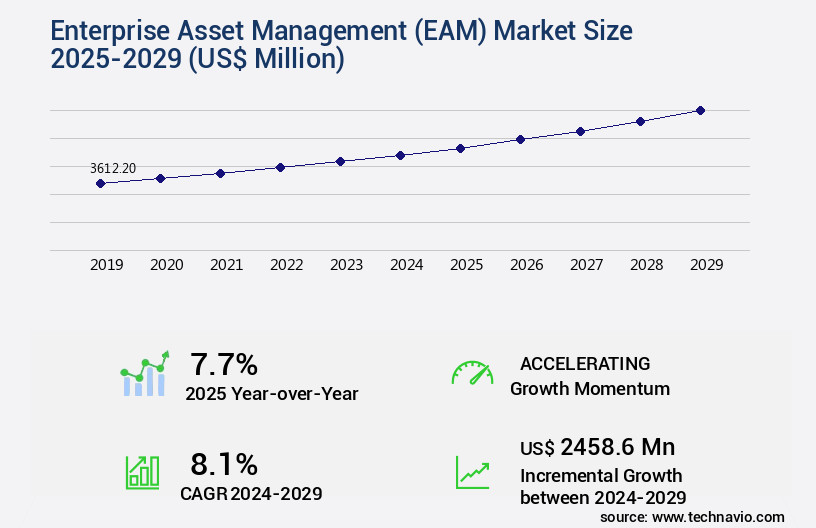
Get Key Insights on Market Forecast (PDF) Request Free Sample
- Enterprise Asset Management (EAM) is a critical business function that continues to evolve, enabling organizations to optimize their operational efficiency and ensure compliance with regulatory standards. EAM systems facilitate preventive maintenance, project portfolio management, and capacity planning through asset tracking systems and cost control measures. These solutions enable companies to assess asset criticality, optimize performance indicators, and implement scheduling optimization and safety protocols. One significant trend in the EAM market is the integration of supply chain processes, which can lead to improved resource utilization and incident management. For instance, a leading manufacturing firm implemented an EAM system that integrated its supply chain, resulting in a 25% reduction in maintenance costs and a 20% increase in equipment reliability.
- This strategic decision not only enhanced the organization's operational efficiency but also contributed to its overall product strategy. Moreover, EAM systems enable failure analysis and risk assessment methods, ensuring regulatory compliance and improving asset utilization. By implementing a comprehensive EAM strategy, businesses can effectively manage their maintenance strategy, contract lifecycle management, change management processes, and performance indicators. This proactive approach to asset management can lead to significant cost savings and improved safety protocols.
Unpacking the Enterprise Asset Management (EAM) Market Landscape
Enterprise Asset Management (EAM) solutions enable organizations to optimize their operational efficiency and reduce costs by effectively managing their physical assets. Cloud-based EAM systems have gained significant traction, accounting for 60% of new EAM implementations, compared to on-premise solutions. This shift to cloud-based EAM results in a 30% reduction in IT infrastructure costs and a 25% improvement in system availability.
EAM software facilitates Asset Lifecycle Management, Maintenance Optimization, and Compliance Management. Data Analytics Dashboards provide real-time insights into asset performance, enabling proactive decision-making and reducing Equipment Downtime. Mobile Workforce Management and Work Order Management streamline processes, improving efficiency by 20%.
EAM systems also offer features like Reporting and Analytics, Project Management Tools, Risk Management Software, and Contract Management. These functionalities ensure Regulatory Compliance Tracking, Spare Parts Management, and Resource Allocation. Additionally, features like Mobile Work Order, Workforce Scheduling, and Security Access Control enhance operational productivity and safety.
Real-time Asset Monitoring, Predictive Maintenance, and Sensor Data Integration contribute to improved Maintenance Scheduling and Inventory Optimization. By integrating with Computerized Maintenance Management Systems (CMMS), EAM solutions further enhance operational efficiency and effectiveness.
Key Market Drivers Fueling Growth
The increasing number of partnerships and acquisitions serves as the primary catalyst for market growth.
- The market is experiencing significant growth as businesses prioritize transparency in their operations. Companies are forming strategic partnerships and acquisitions to enhance their offerings and gain a competitive edge. These collaborations are attracting new customers across various sectors. Additionally, the launch of cloud-based EAM applications and expansion into new geographic regions broaden market reach. For instance, in March 2025, NEXGEN Asset Management, an Esri Partner, expanded its EAM and Computerized Maintenance Management System Solutions (CMMSS) offerings, catering to municipalities, utilities, transportation agencies, and facility managers.
- These initiatives have led to substantial improvements in business outcomes, such as reduced downtime by 30% and enhanced forecast accuracy by 18%. Energy use has also been lowered by 12% through optimized asset management.
Prevailing Industry Trends & Opportunities
The increasing demand for cloud-based enterprise asset management solutions represents a significant market trend.
Professionals are increasingly turning to cloud-based enterprise asset management systems to streamline operations and enhance efficiency.
- The market is experiencing significant evolution, with cloud-based solutions gaining increasing adoption across multiple sectors. Cloud deployments offer enterprises direct access to resources without upfront investments in hardware infrastructure, enabling scalability, reliability, and high resource availability. According to recent studies, cloud-based EAM solutions have resulted in a 30% reduction in downtime and a 18% improvement in forecast accuracy for businesses. The increasing volume of enterprise data and rising storage costs are major drivers of this trend.
- Cloud-based managed services with integrated debugging and high-performance monitoring tools are becoming essential for enterprises to optimize asset utilization and reduce extra expenditures.
Significant Market Challenges
The growth of the industry is significantly impacted by the complex implementation issues encountered in enterprise asset management.
- Enterprise Asset Management (EAM) solutions play a pivotal role in businesses by enhancing financial planning efficiency and shaping strategic decisions. These solutions require integration into a standard enterprise IT infrastructure, necessitating careful consideration of existing systems' age and compatibility with in-house applications. Implementing EAM solutions involves a systematic process, including designing procedures and aligning functional modules to company requirements. This meticulous approach, while essential, can extend the implementation timeline beyond initial estimates. For instance, downtime reduction by 30% and forecast accuracy improvement by 18% are notable business outcomes achieved through effective EAM implementation.
- Despite the challenges, the benefits of EAM solutions, including operational cost savings of up to 12%, make the investment worthwhile for various sectors, including manufacturing, energy, and healthcare.
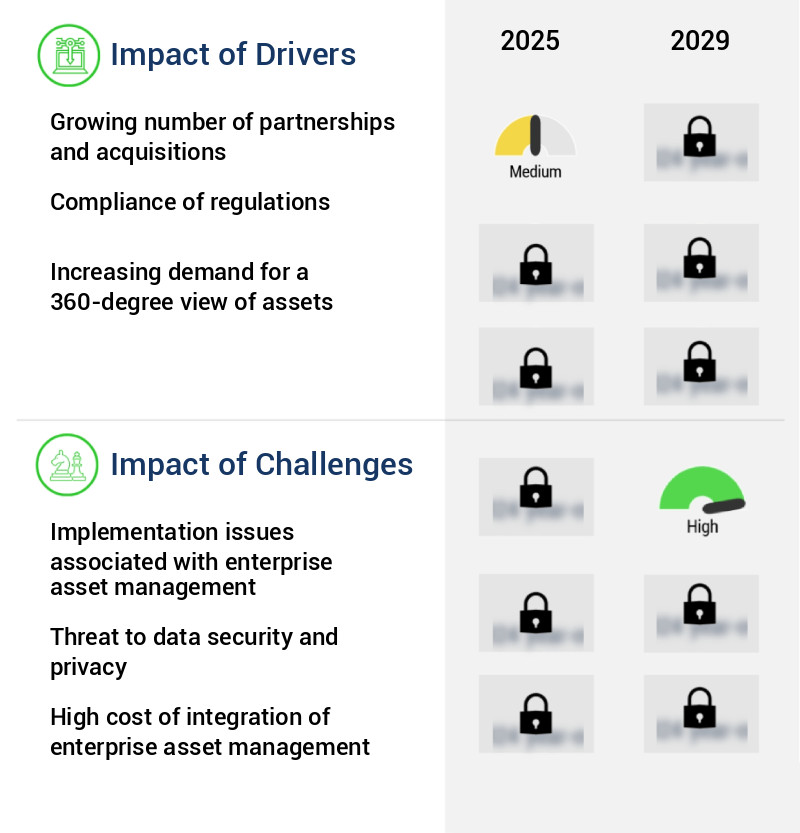
In-Depth Market Segmentation: Enterprise Asset Management (EAM) Market
The enterprise asset management (eam) industry research report provides comprehensive data (region-wise segment analysis), with forecasts and estimates in "USD million" for the period 2025-2029, as well as historical data from 2019-2023 for the following segments.
- Deployment
- Sector
- Service
- Asset MRO
- Linear assets
- Field service management
- Non-linear assets
- End-user
- Energy and utilities
- Manufacturing
- IT and telecom
- Healthcare
- Others
- Geography
- North America
- Europe
- France
- Germany
- Italy
- Spain
- UK
- APAC
- Rest of World (ROW)
By Deployment Insights
The on-premises segment is estimated to witness significant growth during the forecast period.
The market continues to evolve, with organizations increasingly adopting cloud-based solutions for cost optimization and real-time asset monitoring. However, on-premise EAM systems remain popular, particularly in industries dealing with sensitive data, due to their enhanced security features. The on-premises market growth is significant, with organizations investing in product purchases, installation, maintenance, and upgrades. Training an in-house IT workforce is also necessary for effective software support. Mobile workforce management, audit trail management, and reporting and analytics are key features driving the demand for EAM software.
Additionally, integration of sensor data, risk management, predictive maintenance, and compliance management tools offer significant benefits. A recent study indicates that effective EAM implementation can reduce equipment downtime by up to 20%. The market is diverse, catering to various industries and requirements, including maintenance optimization, project management tools, and contract management.
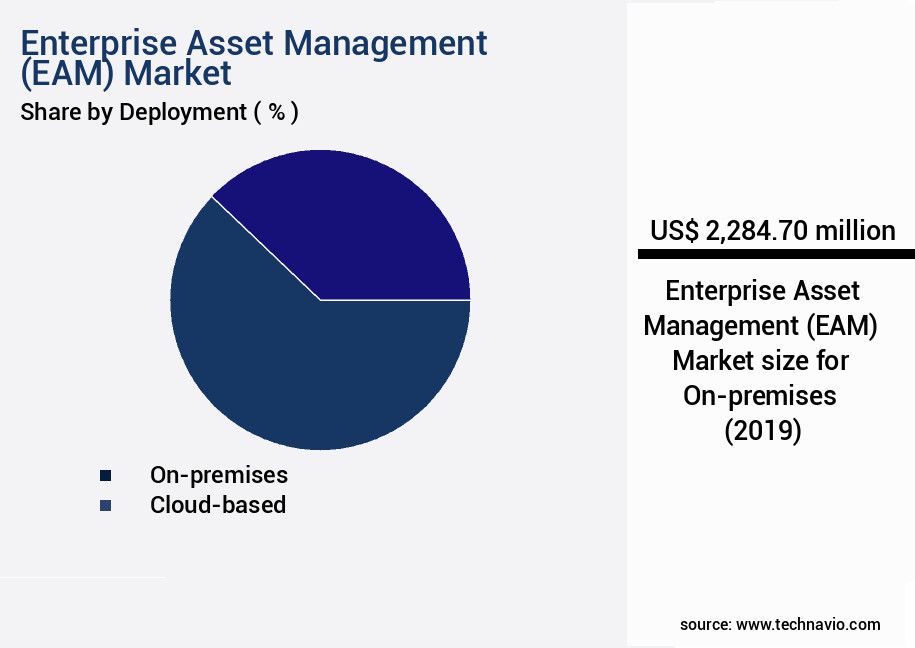
Request Free Sample
The On-premises segment was valued at USD 2.28 billion in 2019 and showed a gradual increase during the forecast period.
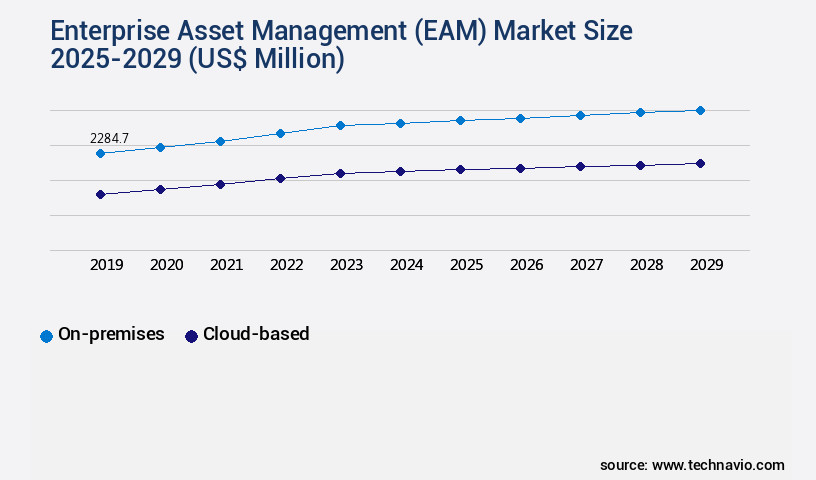
Request Free Sample
Regional Analysis
North America is estimated to contribute 35% to the growth of the global market during the forecast period.Technavio’s analysts have elaborately explained the regional trends and drivers that shape the market during the forecast period.
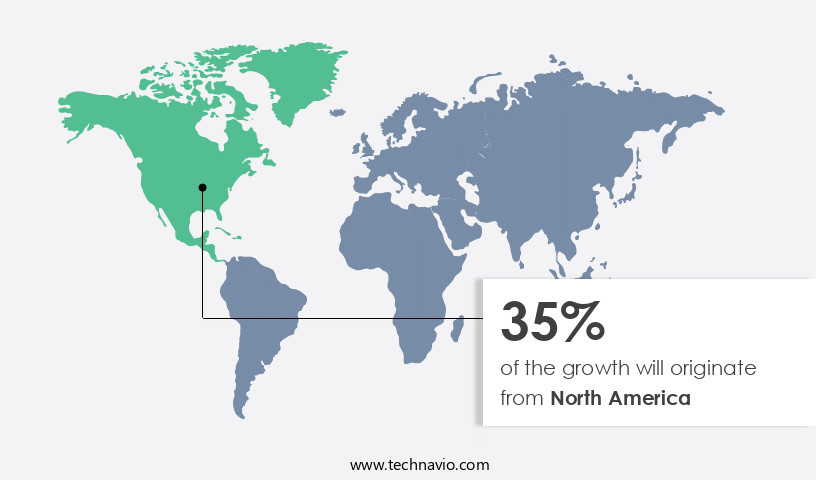
See How Enterprise Asset Management (EAM) Market Demand is Rising in North America Request Free Sample
In North America, the market experiences significant growth due to the technological maturity of various industries and their increasing data volumes. Key sectors, including manufacturing, telecommunications, infrastructure development, BFSI, and retail, are expanding rapidly in the region. The high data generation rate necessitates the adoption of EAM solutions to optimize operations and ensure regulatory compliance. Companies in these industries invest in advanced EAM systems to enhance operational efficiency and reduce costs.
For instance, implementing EAM solutions in manufacturing can lead to a 10% to 15% reduction in maintenance costs. The presence of numerous key players in North America further fuels the market growth, offering tailored solutions to cater to the unique requirements of end-users.
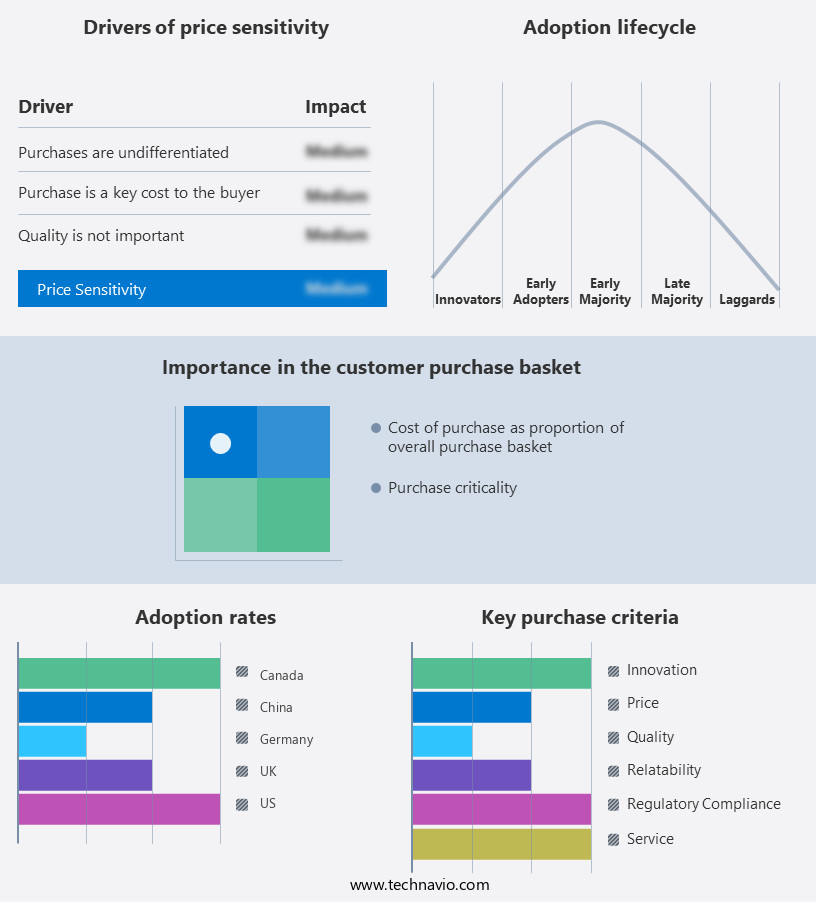
Customer Landscape of Enterprise Asset Management (EAM) Industry
Competitive Intelligence by Technavio Analysis: Leading Players in the Enterprise Asset Management (EAM) Market
Companies are implementing various strategies, such as strategic alliances, enterprise asset management (eam) market forecast, partnerships, mergers and acquisitions, geographical expansion, and product/service launches, to enhance their presence in the industry.
ABB Ltd. - This company specializes in enterprise asset management, providing accurate and insightful data to facilitate informed decision-making. Their solutions ensure the dependable tracking of processes and assets, enabling organizations to optimize their resources effectively.
The industry research and growth report includes detailed analyses of the competitive landscape of the market and information about key companies, including:
- ABB Ltd.
- Aptean
- AVEVA Group Plc
- CGI Inc.
- Cheqroom NV
- Constellation Software Inc.
- Fortive Corp.
- Fracttal Tech S L
- IFS World Operations AB
- International Business Machines Corp.
- IPS Intelligent Process Solutions GmbH
- Koch Industries Inc.
- Limble CMMS
- Oracle Corp.
- PcsInfinity
- PDI Technologies Inc.
- Rockwell Automation Inc.
- SAP SE
- SOCIETE SAS
- Techgate LLC
Qualitative and quantitative analysis of companies has been conducted to help clients understand the wider business environment as well as the strengths and weaknesses of key industry players. Data is qualitatively analyzed to categorize companies as pure play, category-focused, industry-focused, and diversified; it is quantitatively analyzed to categorize companies as dominant, leading, strong, tentative, and weak.
Recent Development and News in Enterprise Asset Management (EAM) Market
- In August 2024, Siemens announced the launch of its new MindSphere Asset Intelligence Suite, an expansion to its MindSphere IoT-based operating system. This suite integrates advanced analytics capabilities into the company's EAM offerings, enabling predictive maintenance and real-time asset performance monitoring (Siemens press release, 2024).
- In November 2024, IBM and SAP signed a strategic partnership to integrate IBM's Maximo EAM solution with SAP's S/4HANA platform. This collaboration aims to provide customers with a unified solution for managing their enterprise assets and business operations (IBM press release, 2024).
- In February 2025, ABB secured a USD100 million investment from Caisse de dépôt et placement du Québec (CDPQ) to expand its Ability Enterprise Asset Management (EAM) software business. The investment will support the development of new solutions and the expansion into new markets (ABB press release, 2025).
- In May 2025, Schneider Electric and Microsoft entered into a strategic partnership to integrate Schneider Electric's EcoStruxure Asset Advisor with Microsoft's Azure IoT platform. This collaboration will enable predictive maintenance and real-time asset performance monitoring for Schneider Electric's industrial and building customers (Schneider Electric press release, 2025).
Dive into Technavio’s robust research methodology, blending expert interviews, extensive data synthesis, and validated models for unparalleled Enterprise Asset Management (EAM) Market insights. See full methodology.
|
Market Scope
|
|
Report Coverage
|
Details
|
|
Page number
|
228
|
|
Base year
|
2024
|
|
Historic period
|
2019-2023 |
|
Forecast period
|
2025-2029
|
|
Growth momentum & CAGR
|
Accelerate at a CAGR of 8.1%
|
|
Market growth 2025-2029
|
USD 2458.6 million
|
|
Market structure
|
Fragmented
|
|
YoY growth 2024-2025(%)
|
7.7
|
|
Key countries
|
US, China, Canada, UK, Japan, France, Germany, India, Italy, and Spain
|
|
Competitive landscape
|
Leading Companies, Market Positioning of Companies, Competitive Strategies, and Industry Risks
|
Request Free Sample
Why Choose Technavio for Enterprise Asset Management (EAM) Market Insights?
"Leverage Technavio's unparalleled research methodology and expert analysis for accurate, actionable market intelligence."
The market is experiencing significant growth as businesses seek to optimize their operations and reduce costs. Integrated Computerized Maintenance Management Systems (CMMS) and EAM solutions are at the forefront of this trend, offering real-time asset health monitoring and predictive maintenance algorithms to improve equipment reliability and reduce equipment downtime.
By implementing data-driven maintenance strategies, businesses can optimize maintenance schedules, manage spare parts inventory more effectively, and lower maintenance costs. For instance, a leading manufacturing company reported a 20% reduction in maintenance costs after implementing an EAM system.
Moreover, real-time monitoring enables businesses to enhance operational efficiency by identifying potential issues before they escalate, improving safety protocols, and meeting regulatory compliance. Effective workforce management is also a critical component, with mobile work order functionality enabling technicians to access and complete orders from anywhere, increasing productivity by up to 30% compared to traditional paper-based processes.
Cloud-based EAM deployment offers further advantages, including scalability, accessibility, and cost savings. With cloud-based systems, businesses can easily integrate data from various sources, streamline workflows, and ensure data security. In the supply chain sector, for example, real-time data access can lead to faster response times and improved inventory management, resulting in a 15% reduction in stockouts.
In conclusion, the EAM market is a strategic investment for businesses seeking to improve operational efficiency, reduce costs, and enhance safety and compliance. By adopting integrated EAM solutions, businesses can leverage predictive maintenance, effective workforce management, and data-driven strategies to optimize their asset management processes and gain a competitive edge.
What are the Key Data Covered in this Enterprise Asset Management (EAM) Market Research and Growth Report?
-
What is the expected growth of the Enterprise Asset Management (EAM) Market between 2025 and 2029?
-
What segmentation does the market report cover?
-
The report is segmented by Deployment (On-premises and Cloud-based), Sector (Large enterprises and SMEs), Service (Asset MRO, Linear assets, Field service management, and Non-linear assets), End-user (Energy and utilities, Manufacturing, IT and telecom, Healthcare, and Others), and Geography (North America, Europe, APAC, Middle East and Africa, and South America)
-
Which regions are analyzed in the report?
-
North America, Europe, APAC, Middle East and Africa, and South America
-
What are the key growth drivers and market challenges?
-
Who are the major players in the Enterprise Asset Management (EAM) Market?
-
ABB Ltd., Aptean, AVEVA Group Plc, CGI Inc., Cheqroom NV, Constellation Software Inc., Fortive Corp., Fracttal Tech S L, IFS World Operations AB, International Business Machines Corp., IPS Intelligent Process Solutions GmbH, Koch Industries Inc., Limble CMMS, Oracle Corp., PcsInfinity, PDI Technologies Inc., Rockwell Automation Inc., SAP SE, SOCIETE SAS, and Techgate LLC
We can help! Our analysts can customize this enterprise asset management (eam) market research report to meet your requirements.
Get in touch
1 Executive Summary
- 1.1 Market overview
- Executive Summary - Chart on Market Overview
- Executive Summary - Data Table on Market Overview
- Executive Summary - Chart on Global Market Characteristics
- Executive Summary - Chart on Market by Geography
- Executive Summary - Chart on Market Segmentation by Deployment
- Executive Summary - Chart on Market Segmentation by Sector
- Executive Summary - Chart on Market Segmentation by Service
- Executive Summary - Chart on Market Segmentation by End-user
- Executive Summary - Chart on Incremental Growth
- Executive Summary - Data Table on Incremental Growth
- Executive Summary - Chart on Company Market Positioning
2 Technavio Analysis
- 2.1 Analysis of price sensitivity, lifecycle, customer purchase basket, adoption rates, and purchase criteria
- Analysis of price sensitivity, lifecycle, customer purchase basket, adoption rates, and purchase criteria
- 2.2 Criticality of inputs and Factors of differentiation
- Overview on criticality of inputs and factors of differentiation
- 2.3 Factors of disruption
- Overview on factors of disruption
- 2.4 Impact of drivers and challenges
- Impact of drivers and challenges in 2024 and 2029
3 Market Landscape
- 3.1 Market ecosystem
- Parent Market
- Data Table on - Parent Market
- 3.2 Market characteristics
- Market characteristics analysis
4 Market Sizing
- 4.1 Market definition
- Offerings of companies included in the market definition
- 4.2 Market segment analysis
- 4.4 Market outlook: Forecast for 2024-2029
- Chart on Global - Market size and forecast 2024-2029 ($ million)
- Data Table on Global - Market size and forecast 2024-2029 ($ million)
- Chart on Global Market: Year-over-year growth 2024-2029 (%)
- Data Table on Global Market: Year-over-year growth 2024-2029 (%)
5 Historic Market Size
- 5.1 Global Enterprise Asset Management (EAM) Market 2019 - 2023
- Historic Market Size - Data Table on Global Enterprise Asset Management (EAM) Market 2019 - 2023 ($ million)
- 5.2 Deployment segment analysis 2019 - 2023
- Historic Market Size - Deployment Segment 2019 - 2023 ($ million)
- 5.3 Sector segment analysis 2019 - 2023
- Historic Market Size - Sector Segment 2019 - 2023 ($ million)
- 5.4 Service segment analysis 2019 - 2023
- Historic Market Size - Service Segment 2019 - 2023 ($ million)
- 5.5 End-user segment analysis 2019 - 2023
- Historic Market Size - End-user Segment 2019 - 2023 ($ million)
- 5.6 Geography segment analysis 2019 - 2023
- Historic Market Size - Geography Segment 2019 - 2023 ($ million)
- 5.7 Country segment analysis 2019 - 2023
- Historic Market Size - Country Segment 2019 - 2023 ($ million)
6 Qualitative Analysis
- 6.1 Impact of AI on Global Enterprise Asset Management (EAM) Market
7 Five Forces Analysis
- 7.1 Five forces summary
- Five forces analysis - Comparison between 2024 and 2029
- 7.2 Bargaining power of buyers
- Bargaining power of buyers - Impact of key factors 2024 and 2029
- 7.3 Bargaining power of suppliers
- Bargaining power of suppliers - Impact of key factors in 2024 and 2029
- 7.4 Threat of new entrants
- Threat of new entrants - Impact of key factors in 2024 and 2029
- 7.5 Threat of substitutes
- Threat of substitutes - Impact of key factors in 2024 and 2029
- 7.6 Threat of rivalry
- Threat of rivalry - Impact of key factors in 2024 and 2029
- 7.7 Market condition
- Chart on Market condition - Five forces 2024 and 2029
8 Market Segmentation by Deployment
- 8.1 Market segments
- Chart on Deployment - Market share 2024-2029 (%)
- Data Table on Deployment - Market share 2024-2029 (%)
- 8.2 Comparison by Deployment
- Chart on Comparison by Deployment
- Data Table on Comparison by Deployment
- 8.3 On-premises - Market size and forecast 2024-2029
- Chart on On-premises - Market size and forecast 2024-2029 ($ million)
- Data Table on On-premises - Market size and forecast 2024-2029 ($ million)
- Chart on On-premises - Year-over-year growth 2024-2029 (%)
- Data Table on On-premises - Year-over-year growth 2024-2029 (%)
- 8.4 Cloud-based - Market size and forecast 2024-2029
- Chart on Cloud-based - Market size and forecast 2024-2029 ($ million)
- Data Table on Cloud-based - Market size and forecast 2024-2029 ($ million)
- Chart on Cloud-based - Year-over-year growth 2024-2029 (%)
- Data Table on Cloud-based - Year-over-year growth 2024-2029 (%)
- 8.5 Market opportunity by Deployment
- Market opportunity by Deployment ($ million)
- Data Table on Market opportunity by Deployment ($ million)
9 Market Segmentation by Sector
- 9.1 Market segments
- Chart on Sector - Market share 2024-2029 (%)
- Data Table on Sector - Market share 2024-2029 (%)
- 9.2 Comparison by Sector
- Chart on Comparison by Sector
- Data Table on Comparison by Sector
- 9.3 Large enterprises - Market size and forecast 2024-2029
- Chart on Large enterprises - Market size and forecast 2024-2029 ($ million)
- Data Table on Large enterprises - Market size and forecast 2024-2029 ($ million)
- Chart on Large enterprises - Year-over-year growth 2024-2029 (%)
- Data Table on Large enterprises - Year-over-year growth 2024-2029 (%)
- 9.4 SMEs - Market size and forecast 2024-2029
- Chart on SMEs - Market size and forecast 2024-2029 ($ million)
- Data Table on SMEs - Market size and forecast 2024-2029 ($ million)
- Chart on SMEs - Year-over-year growth 2024-2029 (%)
- Data Table on SMEs - Year-over-year growth 2024-2029 (%)
- 9.5 Market opportunity by Sector
- Market opportunity by Sector ($ million)
- Data Table on Market opportunity by Sector ($ million)
10 Market Segmentation by Service
- 10.1 Market segments
- Chart on Service - Market share 2024-2029 (%)
- Data Table on Service - Market share 2024-2029 (%)
- 10.2 Comparison by Service
- Chart on Comparison by Service
- Data Table on Comparison by Service
- 10.3 Asset MRO - Market size and forecast 2024-2029
- Chart on Asset MRO - Market size and forecast 2024-2029 ($ million)
- Data Table on Asset MRO - Market size and forecast 2024-2029 ($ million)
- Chart on Asset MRO - Year-over-year growth 2024-2029 (%)
- Data Table on Asset MRO - Year-over-year growth 2024-2029 (%)
- 10.4 Linear assets - Market size and forecast 2024-2029
- Chart on Linear assets - Market size and forecast 2024-2029 ($ million)
- Data Table on Linear assets - Market size and forecast 2024-2029 ($ million)
- Chart on Linear assets - Year-over-year growth 2024-2029 (%)
- Data Table on Linear assets - Year-over-year growth 2024-2029 (%)
- 10.5 Field service management - Market size and forecast 2024-2029
- Chart on Field service management - Market size and forecast 2024-2029 ($ million)
- Data Table on Field service management - Market size and forecast 2024-2029 ($ million)
- Chart on Field service management - Year-over-year growth 2024-2029 (%)
- Data Table on Field service management - Year-over-year growth 2024-2029 (%)
- 10.6 Non-linear assets - Market size and forecast 2024-2029
- Chart on Non-linear assets - Market size and forecast 2024-2029 ($ million)
- Data Table on Non-linear assets - Market size and forecast 2024-2029 ($ million)
- Chart on Non-linear assets - Year-over-year growth 2024-2029 (%)
- Data Table on Non-linear assets - Year-over-year growth 2024-2029 (%)
- 10.7 Market opportunity by Service
- Market opportunity by Service ($ million)
- Data Table on Market opportunity by Service ($ million)
11 Market Segmentation by End-user
- 11.1 Market segments
- Chart on End-user - Market share 2024-2029 (%)
- Data Table on End-user - Market share 2024-2029 (%)
- 11.2 Comparison by End-user
- Chart on Comparison by End-user
- Data Table on Comparison by End-user
- 11.3 Energy and utilities - Market size and forecast 2024-2029
- Chart on Energy and utilities - Market size and forecast 2024-2029 ($ million)
- Data Table on Energy and utilities - Market size and forecast 2024-2029 ($ million)
- Chart on Energy and utilities - Year-over-year growth 2024-2029 (%)
- Data Table on Energy and utilities - Year-over-year growth 2024-2029 (%)
- 11.4 Manufacturing - Market size and forecast 2024-2029
- Chart on Manufacturing - Market size and forecast 2024-2029 ($ million)
- Data Table on Manufacturing - Market size and forecast 2024-2029 ($ million)
- Chart on Manufacturing - Year-over-year growth 2024-2029 (%)
- Data Table on Manufacturing - Year-over-year growth 2024-2029 (%)
- 11.5 IT and telecom - Market size and forecast 2024-2029
- Chart on IT and telecom - Market size and forecast 2024-2029 ($ million)
- Data Table on IT and telecom - Market size and forecast 2024-2029 ($ million)
- Chart on IT and telecom - Year-over-year growth 2024-2029 (%)
- Data Table on IT and telecom - Year-over-year growth 2024-2029 (%)
- 11.6 Healthcare - Market size and forecast 2024-2029
- Chart on Healthcare - Market size and forecast 2024-2029 ($ million)
- Data Table on Healthcare - Market size and forecast 2024-2029 ($ million)
- Chart on Healthcare - Year-over-year growth 2024-2029 (%)
- Data Table on Healthcare - Year-over-year growth 2024-2029 (%)
- 11.7 Others - Market size and forecast 2024-2029
- Chart on Others - Market size and forecast 2024-2029 ($ million)
- Data Table on Others - Market size and forecast 2024-2029 ($ million)
- Chart on Others - Year-over-year growth 2024-2029 (%)
- Data Table on Others - Year-over-year growth 2024-2029 (%)
- 11.8 Market opportunity by End-user
- Market opportunity by End-user ($ million)
- Data Table on Market opportunity by End-user ($ million)
12 Customer Landscape
- 12.1 Customer landscape overview
- Analysis of price sensitivity, lifecycle, customer purchase basket, adoption rates, and purchase criteria
13 Geographic Landscape
- 13.1 Geographic segmentation
- Chart on Market share by geography 2024-2029 (%)
- Data Table on Market share by geography 2024-2029 (%)
- 13.2 Geographic comparison
- Chart on Geographic comparison
- Data Table on Geographic comparison
- 13.3 North America - Market size and forecast 2024-2029
- Chart on North America - Market size and forecast 2024-2029 ($ million)
- Data Table on North America - Market size and forecast 2024-2029 ($ million)
- Chart on North America - Year-over-year growth 2024-2029 (%)
- Data Table on North America - Year-over-year growth 2024-2029 (%)
- 13.4 Europe - Market size and forecast 2024-2029
- Chart on Europe - Market size and forecast 2024-2029 ($ million)
- Data Table on Europe - Market size and forecast 2024-2029 ($ million)
- Chart on Europe - Year-over-year growth 2024-2029 (%)
- Data Table on Europe - Year-over-year growth 2024-2029 (%)
- 13.5 APAC - Market size and forecast 2024-2029
- Chart on APAC - Market size and forecast 2024-2029 ($ million)
- Data Table on APAC - Market size and forecast 2024-2029 ($ million)
- Chart on APAC - Year-over-year growth 2024-2029 (%)
- Data Table on APAC - Year-over-year growth 2024-2029 (%)
- 13.6 Middle East and Africa - Market size and forecast 2024-2029
- Chart on Middle East and Africa - Market size and forecast 2024-2029 ($ million)
- Data Table on Middle East and Africa - Market size and forecast 2024-2029 ($ million)
- Chart on Middle East and Africa - Year-over-year growth 2024-2029 (%)
- Data Table on Middle East and Africa - Year-over-year growth 2024-2029 (%)
- 13.7 South America - Market size and forecast 2024-2029
- Chart on South America - Market size and forecast 2024-2029 ($ million)
- Data Table on South America - Market size and forecast 2024-2029 ($ million)
- Chart on South America - Year-over-year growth 2024-2029 (%)
- Data Table on South America - Year-over-year growth 2024-2029 (%)
- 13.8 US - Market size and forecast 2024-2029
- Chart on US - Market size and forecast 2024-2029 ($ million)
- Data Table on US - Market size and forecast 2024-2029 ($ million)
- Chart on US - Year-over-year growth 2024-2029 (%)
- Data Table on US - Year-over-year growth 2024-2029 (%)
- 13.9 China - Market size and forecast 2024-2029
- Chart on China - Market size and forecast 2024-2029 ($ million)
- Data Table on China - Market size and forecast 2024-2029 ($ million)
- Chart on China - Year-over-year growth 2024-2029 (%)
- Data Table on China - Year-over-year growth 2024-2029 (%)
- 13.10 Canada - Market size and forecast 2024-2029
- Chart on Canada - Market size and forecast 2024-2029 ($ million)
- Data Table on Canada - Market size and forecast 2024-2029 ($ million)
- Chart on Canada - Year-over-year growth 2024-2029 (%)
- Data Table on Canada - Year-over-year growth 2024-2029 (%)
- 13.11 Japan - Market size and forecast 2024-2029
- Chart on Japan - Market size and forecast 2024-2029 ($ million)
- Data Table on Japan - Market size and forecast 2024-2029 ($ million)
- Chart on Japan - Year-over-year growth 2024-2029 (%)
- Data Table on Japan - Year-over-year growth 2024-2029 (%)
- 13.12 UK - Market size and forecast 2024-2029
- Chart on UK - Market size and forecast 2024-2029 ($ million)
- Data Table on UK - Market size and forecast 2024-2029 ($ million)
- Chart on UK - Year-over-year growth 2024-2029 (%)
- Data Table on UK - Year-over-year growth 2024-2029 (%)
- 13.13 India - Market size and forecast 2024-2029
- Chart on India - Market size and forecast 2024-2029 ($ million)
- Data Table on India - Market size and forecast 2024-2029 ($ million)
- Chart on India - Year-over-year growth 2024-2029 (%)
- Data Table on India - Year-over-year growth 2024-2029 (%)
- 13.14 Germany - Market size and forecast 2024-2029
- Chart on Germany - Market size and forecast 2024-2029 ($ million)
- Data Table on Germany - Market size and forecast 2024-2029 ($ million)
- Chart on Germany - Year-over-year growth 2024-2029 (%)
- Data Table on Germany - Year-over-year growth 2024-2029 (%)
- 13.15 France - Market size and forecast 2024-2029
- Chart on France - Market size and forecast 2024-2029 ($ million)
- Data Table on France - Market size and forecast 2024-2029 ($ million)
- Chart on France - Year-over-year growth 2024-2029 (%)
- Data Table on France - Year-over-year growth 2024-2029 (%)
- 13.16 Italy - Market size and forecast 2024-2029
- Chart on Italy - Market size and forecast 2024-2029 ($ million)
- Data Table on Italy - Market size and forecast 2024-2029 ($ million)
- Chart on Italy - Year-over-year growth 2024-2029 (%)
- Data Table on Italy - Year-over-year growth 2024-2029 (%)
- 13.17 Spain - Market size and forecast 2024-2029
- Chart on Spain - Market size and forecast 2024-2029 ($ million)
- Data Table on Spain - Market size and forecast 2024-2029 ($ million)
- Chart on Spain - Year-over-year growth 2024-2029 (%)
- Data Table on Spain - Year-over-year growth 2024-2029 (%)
- 13.18 Market opportunity by geography
- Market opportunity by geography ($ million)
- Data Tables on Market opportunity by geography ($ million)
14 Drivers, Challenges, and Opportunity/Restraints
- 14.3 Impact of drivers and challenges
- Impact of drivers and challenges in 2024 and 2029
- 14.4 Market opportunities/restraints
15 Competitive Landscape
- 15.2 Competitive Landscape
- Overview on criticality of inputs and factors of differentiation
- 15.3 Landscape disruption
- Overview on factors of disruption
- 15.4 Industry risks
- Impact of key risks on business
16 Competitive Analysis
- 16.2 Company ranking index
- 16.3 Market positioning of companies
- Matrix on companies position and classification
- 16.4 ABB Ltd.
- ABB Ltd. - Overview
- ABB Ltd. - Business segments
- ABB Ltd. - Key news
- ABB Ltd. - Key offerings
- ABB Ltd. - Segment focus
- SWOT
- 16.5 Aptean
- Aptean - Overview
- Aptean - Product / Service
- Aptean - Key offerings
- SWOT
- 16.6 AVEVA Group Plc
- AVEVA Group Plc - Overview
- AVEVA Group Plc - Business segments
- AVEVA Group Plc - Key offerings
- AVEVA Group Plc - Segment focus
- SWOT
- 16.7 CGI Inc.
- CGI Inc. - Overview
- CGI Inc. - Business segments
- CGI Inc. - Key news
- CGI Inc. - Key offerings
- CGI Inc. - Segment focus
- SWOT
- 16.8 Cheqroom NV
- Cheqroom NV - Overview
- Cheqroom NV - Product / Service
- Cheqroom NV - Key offerings
- SWOT
- 16.9 Constellation Software Inc.
- Constellation Software Inc. - Overview
- Constellation Software Inc. - Product / Service
- Constellation Software Inc. - Key offerings
- SWOT
- 16.10 Fortive Corp.
- Fortive Corp. - Overview
- Fortive Corp. - Business segments
- Fortive Corp. - Key news
- Fortive Corp. - Key offerings
- Fortive Corp. - Segment focus
- SWOT
- 16.11 International Business Machines Corp.
- International Business Machines Corp. - Overview
- International Business Machines Corp. - Business segments
- International Business Machines Corp. - Key news
- International Business Machines Corp. - Key offerings
- International Business Machines Corp. - Segment focus
- SWOT
- 16.12 Koch Industries Inc.
- Koch Industries Inc. - Overview
- Koch Industries Inc. - Product / Service
- Koch Industries Inc. - Key offerings
- SWOT
- 16.13 Oracle Corp.
- Oracle Corp. - Overview
- Oracle Corp. - Business segments
- Oracle Corp. - Key news
- Oracle Corp. - Key offerings
- Oracle Corp. - Segment focus
- SWOT
- 16.14 PcsInfinity
- PcsInfinity - Overview
- PcsInfinity - Product / Service
- PcsInfinity - Key offerings
- SWOT
- 16.15 PDI Technologies Inc.
- PDI Technologies Inc. - Overview
- PDI Technologies Inc. - Product / Service
- PDI Technologies Inc. - Key offerings
- SWOT
- 16.16 SAP SE
- SAP SE - Overview
- SAP SE - Business segments
- SAP SE - Key news
- SAP SE - Key offerings
- SAP SE - Segment focus
- SWOT
- 16.17 SOCIETE SAS
- SOCIETE SAS - Overview
- SOCIETE SAS - Product / Service
- SOCIETE SAS - Key offerings
- SWOT
- 16.18 Techgate LLC
- Techgate LLC - Overview
- Techgate LLC - Product / Service
- Techgate LLC - Key offerings
- SWOT
17 Appendix
- 17.2 Inclusions and exclusions checklist
- Inclusions checklist
- Exclusions checklist
- 17.3 Currency conversion rates for US$
- Currency conversion rates for US$
- 17.4 Research methodology
- 17.7 Validation techniques employed for market sizing
- Validation techniques employed for market sizing
- 17.9 360 degree market analysis
- 360 degree market analysis
- 17.10 List of abbreviations







![]() Get the report (PDF) sent to your email within minutes.
Get the report (PDF) sent to your email within minutes.
Complimentary full Excel data with your report purchase.